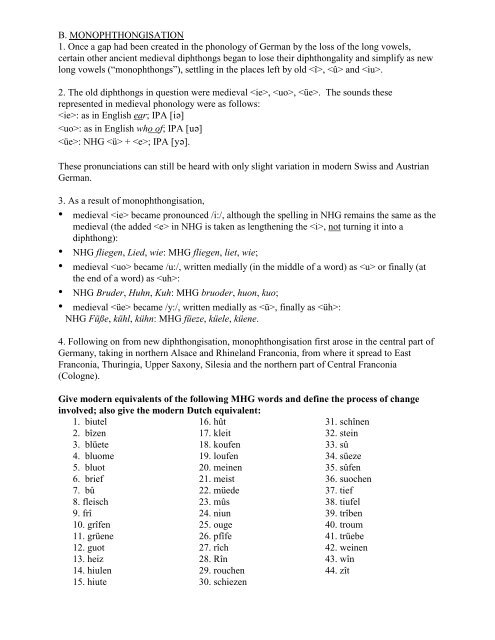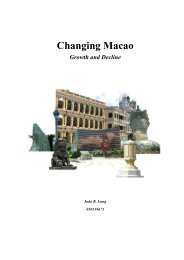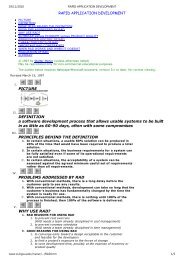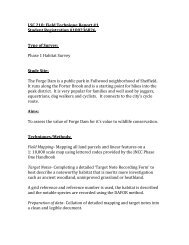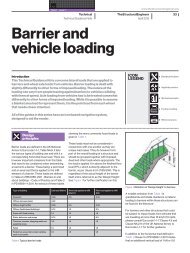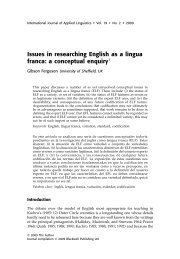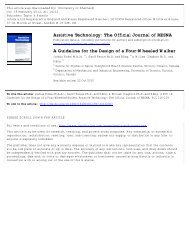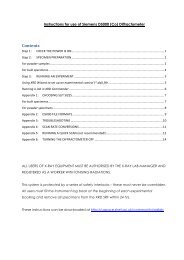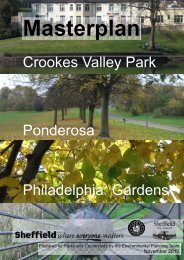A. DIPHTHONGISATION 1. The three main diphthongs of ... - uSpace
A. DIPHTHONGISATION 1. The three main diphthongs of ... - uSpace
A. DIPHTHONGISATION 1. The three main diphthongs of ... - uSpace
Create successful ePaper yourself
Turn your PDF publications into a flip-book with our unique Google optimized e-Paper software.
B. MONOPHTHONGISATION<br />
<strong>1.</strong> Once a gap had been created in the phonology <strong>of</strong> German by the loss <strong>of</strong> the long vowels,<br />
certain other ancient medieval <strong>diphthongs</strong> began to lose their diphthongality and simplify as new<br />
long vowels (“monophthongs”), settling in the places left by old , and .<br />
2. <strong>The</strong> old <strong>diphthongs</strong> in question were medieval , , . <strong>The</strong> sounds these<br />
represented in medieval phonology were as follows:<br />
: as in English ear; IPA []<br />
: as in English who <strong>of</strong>; IPA []<br />
: NHG + ; IPA [].<br />
<strong>The</strong>se pronunciations can still be heard with only slight variation in modern Swiss and Austrian<br />
German.<br />
3. As a result <strong>of</strong> monophthongisation,<br />
• medieval became pronounced /i:/, although the spelling in NHG re<strong>main</strong>s the same as the<br />
medieval (the added in NHG is taken as lengthening the , not turning it into a<br />
diphthong):<br />
• NHG fliegen, Lied, wie: MHG fliegen, liet, wie;<br />
• medieval became /u:/, written medially (in the middle <strong>of</strong> a word) as or finally (at<br />
the end <strong>of</strong> a word) as :<br />
• NHG Bruder, Huhn, Kuh: MHG bruoder, huon, kuo;<br />
• medieval became /y:/, written medially as , finally as :<br />
NHG Füße, kühl, kühn: MHG füeze, küele, küene.<br />
4. Following on from new diphthongisation, monophthongisation first arose in the central part <strong>of</strong><br />
Germany, taking in northern Alsace and Rhineland Franconia, from where it spread to East<br />
Franconia, Thuringia, Upper Saxony, Silesia and the northern part <strong>of</strong> Central Franconia<br />
(Cologne).<br />
Give modern equivalents <strong>of</strong> the following MHG words and define the process <strong>of</strong> change<br />
involved; also give the modern Dutch equivalent:<br />
<strong>1.</strong> biutel<br />
2. bîzen<br />
3. blüete<br />
4. bluome<br />
5. bluot<br />
6. brief<br />
7. bû<br />
8. fleisch<br />
9. frî<br />
10. grîfen<br />
1<strong>1.</strong> grüene<br />
12. guot<br />
13. heiz<br />
14. hiulen<br />
15. hiute<br />
16. hût<br />
17. kleit<br />
18. koufen<br />
19. loufen<br />
20. meinen<br />
2<strong>1.</strong> meist<br />
22. müede<br />
23. mûs<br />
24. niun<br />
25. ouge<br />
26. pfîfe<br />
27. rîch<br />
28. Rîn<br />
29. rouchen<br />
30. schiezen<br />
3<strong>1.</strong> schînen<br />
32. stein<br />
33. sû<br />
34. süeze<br />
35. sûfen<br />
36. suochen<br />
37. tief<br />
38. tiufel<br />
39. trîben<br />
40. troum<br />
4<strong>1.</strong> trüebe<br />
42. weinen<br />
43. wîn<br />
44. zît


